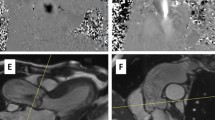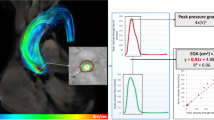Abstract
This study aims to systematically verify if the simplified geometry and flow profile of the left ventricular outflow tract (LVOT) assumed in 2D echocardiography is appropriate while examining the utility of 4D flow MRI to assess valvular disease. This prospective study obtained same-day Doppler echocardiography and 4D flow MRI in 37 healthy volunteers (age: 51.9 ± 18.2, 20 females) and 7 aortic stenosis (AS) patients (age: 64.2 ± 9.6, 1 female). Two critical assumptions made in echocardiography for aortic valve area assessment were examined, i.e. the assumption of (1) a circular LVOT shape and (2) a flat velocity profile through the LVOT. 3D velocity and shape information obtained with 4D flow MRI was used as comparison. It was found that the LVOT area was lower (by 26.5% and 24.5%) and the velocity time integral (VTI) was higher (by 28.5% and 30.2%) with echo in the healthy and AS group, respectively. These competing errors largely cancelled out when examining individual and cohort averaged LVOT stroke volume. The LVOT area, VTI and stroke volume measured by echo and 4D flow MRI were 3.6 ± 0.7 vs. 4.9 ± 1.0 cm2 (p < 0.001), 21.2 ± 3.0 vs 15.2 ± 2.8 cm (p < 0.001), and 75.6 ± 15.6 vs 72.8 ± 14.1 ml (p = 0.3376), respectively. In the ensemble average of LVOT area and VTI, under- and over-estimation seem to compensate each other to result in a ‘realistic’ stroke volume. However, it is important to understand that this compensation may fail. 4D flow MRI provides a unique insight into this phenomenon.






Similar content being viewed by others
Availability of data and material
Not applicable.
Code availability
Not applicable.
References
Osnabrugge RL, Mylotte D, Head SJ, Van Mieghem NM, Nkomo VT, LeReun CM et al (2013) Aortic stenosis in the elderly: disease prevalence and number of candidates for transcatheter aortic valve replacement: a meta-analysis and modeling study. J Am Coll Cardiol 62(11):1002–1012
Nishimura R, Otto C, Bonow R, Carabello B, Erwin J 3rd, Guyton R et al (2014) ACC/AHA Task Force Members. 2014 AHA/ACC guideline for the management of patients with valvular heart disease: a report of the American College of Cardiology/American Heart Association Task Force on Practice Guidelines. Circulation 129(23):e521–e643
Nishimura RA, Otto CM, Bonow RO, Carabello BA, Erwin JP, Fleisher LA et al (2017) 2017 AHA/ACC focused update of the 2014 AHA/ACC guideline for the management of patients with valvular heart disease: a report of the American College of Cardiology/American Heart Association Task Force on Clinical Practice Guidelines. J Am Coll Cardiol 70(2):252–289
Burgstahler C, Kunze M, Loffler C, Gawaz MP, Hombach V, Merkle N (2006) Assessment of left ventricular outflow tract geometry in non-stenotic and stenotic aortic valves by cardiovascular magnetic resonance. J Cardiovasc Magn Reson 8(6):825–829
Doddamani S, Grushko MJ, Makaryus AN, Jain VR, Bello R, Friedman MA et al (2009) Demonstration of left ventricular outflow tract eccentricity by 64-slice multi-detector CT. Int J Cardiovasc Imaging 25(2):175–181
Tanaka K, Makaryus AN, Wolff SD (2007) Correlation of aortic valve area obtained by the velocity-encoded phase contrast continuity method to direct planimetry using cardiovascular magnetic resonance. J Cardiovasc Magn Reson 9(5):799–805
Utsunomiya H, Yamamoto H, Horiguchi J, Kunita E, Okada T, Yamazato R et al (2012) Underestimation of aortic valve area in calcified aortic valve disease: effects of left ventricular outflow tract ellipticity. Int J Cardiol 157(3):347–353
Hazirolan T, Tasbas B, Dagoglu MG, Canyigit M, Abali G, Aytemir K et al (2007) Comparison of short and long axis methods in cardiac MR imaging and echocardiography for left ventricular function. Diagn Interv Radiol 13(1):33
Kara B, Nayman A, Guler I, Gul EE, Koplay M, Paksoy Y (2016) Quantitative assessment of left ventricular function and myocardial mass: a comparison of coronary CT angiography with cardiac MRI and echocardiography. Pol J Radiol 81:95
Sucang L, Weinert L, Mor-Avi V, Neil J, Ebner C, Steringer-Mascherbauer R et al (eds) (2006) Quantitative assessment of left ventricular size and function: Side-by-side comparison of three dimensional echocardiography and computed tomography against magnetic resonance reference. Elsevier, New York
Markl M, Frydrychowicz A, Kozerke S, Hope M, Wieben O (2012) 4D flow MRI. J Magn Reson Imaging 36(5):1015–1036
Markl M, Kilner PJ, Ebbers T (2011) Comprehensive 4D velocity mapping of the heart and great vessels by cardiovascular magnetic resonance. J Cardiovasc Magn Reson 13(1):7
Garcia J, Barker AJ, Murphy I, Jarvis K, Schnell S, Collins JD et al (2016) Four-dimensional flow magnetic resonance imaging-based characterization of aortic morphometry and haemodynamics: impact of age, aortic diameter, and valve morphology. Eur Heart J Cardiovasc Imaging 17(8):877–884
Walmsley R (1979) Anatomy of left ventricular outflow tract. Br Heart J 41(3):263–267
Baumgartner H, Hung J, Bermejo J, Chambers JB, Edvardsen T, Goldstein S et al (2017) Recommendations on the echocardiographic assessment of aortic valve stenosis: a focused update from the European Association of Cardiovascular Imaging and the American Society of Echocardiography. J Am Soc Echocardiogr 30(4):372–392
Baumgartner H, Hung J, Bermejo J, Chambers JB, Evangelista A, Griffin BP et al (2009) Echocardiographic assessment of valve stenosis: EAE/ASE recommendations for clinical practice. J Am Soc Echocardiogr 22(1):1–23 (quiz 101-2)
Jabbour A, Ismail TF, Moat N, Gulati A, Roussin I, Alpendurada F et al (2011) Multimodality imaging in transcatheter aortic valve implantation and post-procedural aortic regurgitation: comparison among cardiovascular magnetic resonance, cardiac computed tomography, and echocardiography. J Am Coll Cardiol 58(21):2165–2173
Caruthers SD, Lin SJ, Brown P, Watkins MP, Williams TA, Lehr KA et al (2003) Practical value of cardiac magnetic resonance imaging for clinical quantification of aortic valve stenosis: comparison with echocardiography. Circulation 108(18):2236–2243
Reant P, Lederlin M, Lafitte S, Serri K, Montaudon M, Corneloup O et al (2006) Absolute assessment of aortic valve stenosis by planimetry using cardiovascular magnetic resonance imaging: comparison with transesophageal echocardiography, transthoracic echocardiography, and cardiac catheterisation. Eur J Radiol 59(2):276–283
Kupfahl C, Honold M, Meinhardt G, Vogelsberg H, Wagner A, Mahrholdt H et al (2004) Evaluation of aortic stenosis by cardiovascular magnetic resonance imaging: comparison with established routine clinical techniques. Heart 90(8):893–901
Defrance C, Bollache E, Kachenoura N, Perdrix L, Hrynchyshyn N, Bruguiere E et al (2012) Evaluation of aortic valve stenosis using cardiovascular magnetic resonance: comparison of an original semiautomated analysis of phase-contrast cardiovascular magnetic resonance with Doppler echocardiography. Circ Cardiovasc Imaging 5(5):604–612
Maes F, Pierard S, de Meester C, Boulif J, Amzulescu M, Vancraeynest D et al (2017) Impact of left ventricular outflow tract ellipticity on the grading of aortic stenosis in patients with healthy ejection fraction. J Cardiovasc Magn Reson 19(1):37
Sagmeister F, Weininger M, Herrmann S, Bernhardt P, Rasche V, Bauernschmitt R et al (2018) Extent of size, shape and systolic variability of the left ventricular outflow tract in aortic stenosis determined by phase-contrast MRI. Magn Reson Imaging 45:58–65
Yunus AC (2020) Fluid mechanics: fundamentals and applications (SI units). Tata McGraw Hill Education Private Limited, New York
Barone-Rochette G, Piérard S, Seldrum S, de Ravenstein CdM, Melchior J, Maes F et al (2013) Aortic valve area, stroke volume, left ventricular hypertrophy, remodeling and fibrosis in aortic stenosis assessed by cardiac MRI: comparison between high and low gradient, and healthy and low flow aortic stenosis. Circ: Cardiovasc Imaging 6:1009–1017
Garcia J, Kadem L, Larose E, Clavel M-A, Pibarot P (2011) Comparison between cardiovascular magnetic resonance and transthoracic Doppler echocardiography for the estimation of effective orifice area in aortic stenosis. J Cardiovasc Magn Reson 13(1):25
Garcia J, Barker AJ, Markl M (2019) The role of imaging of flow patterns by 4D flow MRI in aortic stenosis. JACC: Cardiovasc Imaging 12(2):252–266
Garcia J, Markl M, Schnell S, Allen B, Entezari P, Mahadevia R et al (2014) Evaluation of aortic stenosis severity using 4D flow jet shear layer detection for the measurement of valve effective orifice area. Magn Reson Imaging 32(7):891–898
Omran H, Schmidt H, Hackenbroch M, Illien S, Bernhardt P, von der Recke G et al (2003) Silent and apparent cerebral embolism after retrograde catheterisation of the aortic valve in valvular stenosis: a prospective, randomised study. The Lancet 361(9365):1241–1246
Petersson S, Dyverfeldt P, Gårdhagen R, Karlsson M, Ebbers T (2010) Simulation of phase contrast MRI of turbulent flow. Magn Reson Med 64(4):1039–1046
Doddamani S, Bello R, Friedman MA, Banerjee A, Bowers JH Jr, Kim B et al (2007) Demonstration of left ventricular outflow tract eccentricity by real time 3D echocardiography: implications for the determination of aortic valve area. Echocardiography 24(8):860–866
Sahn DJ, Mathur P, Amacher K, Tracy E, Ashraf M (2016) 3D echocardiography enhanced area measurements of the left ventricular outflow tract improves assessment of stroke volume: comparison with 2D echo. J Am Coll Cardiol 67(13 Supplement):1653
Acknowledgements
NIHLBI R01HL115828, NIH R01HL133504, NIH K25HL119608, The Irene D. Pritzker Foundation, GE Medical Services, Abbott Vascular, Daegu-Gyeongbuk/Osong Medical Cluster R&D Project (Ministry of Science and ICT, the Ministry of Trade, Industry and Energy, the Ministry of Health & Welfare, Republic of Korea : HI19C0760 and 2021R1C1C1003481)
Funding
NIHLBI R01HL115828, NIH R01HL133504, NIH K25HL119608, The Irene D. Pritzker Foundation, GE Medical Services, Abbott Vascular, Daegu-Gyeongbuk/Osong Medical Cluster R&D Project (Ministry of Science and ICT, the Ministry of Trade, Industry and Energy, the Ministry of Health & Welfare, Republic of Korea: HI19C0760 and 2021R1C1C1003481).
Author information
Authors and Affiliations
Contributions
HH, JL AJB, and MK: Data analysis, manuscript writing and editing. MM, JDT and AJB: Study organization, manuscript editing.
Corresponding author
Ethics declarations
Conflict of interest
The authors declare that they have no conflict of interest.
Ethical approval
This study was approved by Northwestern University Institutional Review Board(IRB: STU00204258).
Consent to participate
All participants provided the Northwestern University IRB approved written informed consent and the study.
Consent for publication
All participants agreed to the informed consent regarding publishing their data and clinical images.
Additional information
Publisher's Note
Springer Nature remains neutral with regard to jurisdictional claims in published maps and institutional affiliations.
Rights and permissions
About this article
Cite this article
Huh, H., Lee, J., Kinno, M. et al. Two wrongs sometimes do make a right: errors in aortic valve stenosis assessment by same-day Doppler echocardiography and 4D flow MRI. Int J Cardiovasc Imaging 38, 1815–1823 (2022). https://doi.org/10.1007/s10554-022-02553-8
Received:
Accepted:
Published:
Issue Date:
DOI: https://doi.org/10.1007/s10554-022-02553-8




